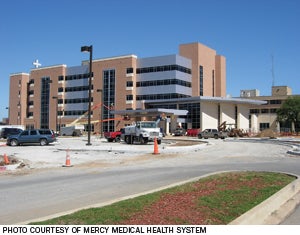Industry expects post-reform boost in construction activity
 |
| Mercy Memorial Health Center's patient tower in Ardmore, Okla., is scheduled to open this month. |
Now that health care reform has passed, hospital leaders, builders and architects say the way is clearer to move ahead with construction plans.
For most hospitals, the recent passage of the Patient Protection and Affordable Care Act means they can proceed with new construction and expansion plans knowing that 32 million more Americans will have health insurance. They also know they'll have to cope with tough new Medicare payment limits on readmissions and with more low-paying Medicaid patients.
"With a little more certainty about health care reform and the economy getting back on its feet, there will be a modest increase in new hospital development in 2010 and further increases in the next couple of years," says Kim Kennedy, manager of forecasting for
McGraw-Hill Construction Research & Analytics.
"We're seeing large health care systems begin to move forward with their programs," says Todd Freed, vice president of health care operations for the St. Louis-based McCarthy Building Companies. "They're seeing [reform] as an opportunity for expansion."
Nationally, there was a 34 percent decline last year in the dollar value of construction starts for hospitals and other health care facilities, from $30 billion in 2008 to $19.8 billion, according to Kennedy. Through the first four months of this year, McGraw-Hill Construction reports $6.2 billion in new construction starts under way, down 3.9 percent from the same time last year. By the end of the year, they expect the market to recover with a 7 percent gain to $21.3 billion.
The Chesterfield, Mo.-based Sisters of Mercy System, which currently is completing new patient towers in Oklahoma and Missouri, slowed other construction plans over the past 18 months because of the bad economy.
But Jim Jaacks, Mercy's executive vice president, says his 30-hospital system is well-positioned to succeed under federal reforms that peg payment to quality outcomes. Its leaders are meeting with leaders in the communities Mercy serves to develop capital plans for the next five years. New projects, he says, probably will be more focused on outpatient than inpatient facilities. "The expansion of coverage will allow better access to outpatient care," Jaacks says. "I don't see it increasing demand for inpatient beds."
Virginia Mason Medical Center in Seattle broke ground on a new patient tower early last year but has no other inpatient facilities currently planned. Stephen Grose, administrative director of support services, said the passage of health care reform means "we're no longer frozen because of the unknown. Now we can start creating a vision for the future."
A big part of that vision, Grose believes, is tailoring hospital design and construction to enhance quality and patient safety and lower operating costs—such as improving ventilation, materials and room design to reduce infections and patient falls. "If hospitals don't get paid for readmissions, the first point of care has to be the last point of care," he says. Facility directors and designers will have to work more closely with clinicians to accomplish this, he adds.
Dan Noble, executive vice president and director of design at Dallas-based HKS Architects, already is seeing that trend. HKS has experienced a 40 percent jump in its health care work in the first quarter of 2010 compared with last year—most of it planning and front-end activity. "Our clients want us to analyze their operations and fine-tune their buildings for efficiency and better results," Noble says.




